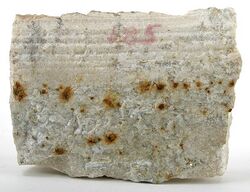Chemistry:Eucryptite
| Eucryptite | |
|---|---|
 Eucryptite grains in albite from the type locality (size: 9.3 × 7.0 × 2.8 cm) | |
| General | |
| Category | Silicate mineral |
| Formula (repeating unit) | LiAlSiO4 |
| Crystal system | Trigonal |
| Crystal class | Rhombohedral (3) H-M symbol: (3) |
| Space group | R3 |
| Unit cell | a = 13.48, c = 9.01 [Å]; Z = 18 |
| Identification | |
| Color | Brown, colorless, white |
| Crystal habit | Rare as euhedral crystals, coarse crystalline aggregates and massive |
| Cleavage | Indistinct on {1010} and {0001} |
| Fracture | Conchoidal |
| Tenacity | Very brittle |
| Mohs scale hardness | 6.5 |
| |re|er}} | Vitreous |
| Streak | White |
| Diaphaneity | Transparent to translucent |
| Density | 2.67 |
| Optical properties | Uniaxial (+) |
| Refractive index | nω = 1.570 – 1.573 nε = 1.583 – 1.587 |
| Birefringence | δ = 0.013 |
| Other characteristics | Fluoresces pink to red or orange under SW UV |
| References | [1][2][3] |
Eucryptite is a lithium bearing aluminium silicate mineral with formula LiAlSiO4. It crystallizes in the trigonal – rhombohedral crystal system. It typically occurs as granular to massive in form and may pseudomorphically replace spodumene. It has a brittle to conchoidal fracture and indistinct cleavage. It is transparent to translucent and varies from colorless to white to brown. It has a Mohs hardness of 6.5 and a specific gravity of 2.67. Optically it is uniaxial positive with refractive index values of nω = 1.570 – 1.573 and nε = 1.583 – 1.587.
Its typical occurrence is in lithium-rich pegmatites in association with albite, spodumene, petalite, amblygonite, lepidolite and quartz.[2]
It occurs as a secondary alteration product of spodumene. It was first described in 1880 for an occurrence at its type locality, Branchville, Connecticut.[1] Its name was from the Greek for well concealed, for its typical occurrence embedded in albite.[1][2]
References
- ↑ 1.0 1.1 1.2 Mindat.org
- ↑ 2.0 2.1 2.2 Handbook of Mineralogy
- ↑ Webmineral data
- ↑ Warr, L.N. (2021). "IMA–CNMNC approved mineral symbols". Mineralogical Magazine 85 (3): 291–320. doi:10.1180/mgm.2021.43. Bibcode: 2021MinM...85..291W.
 |

